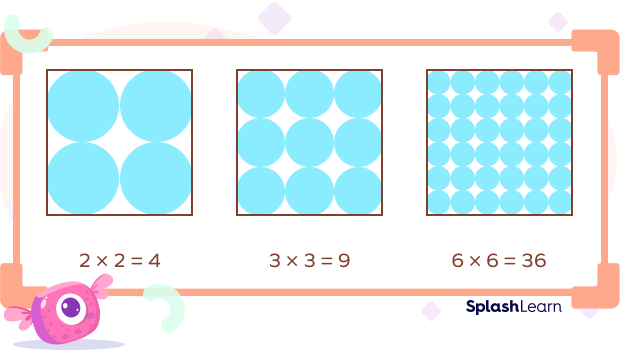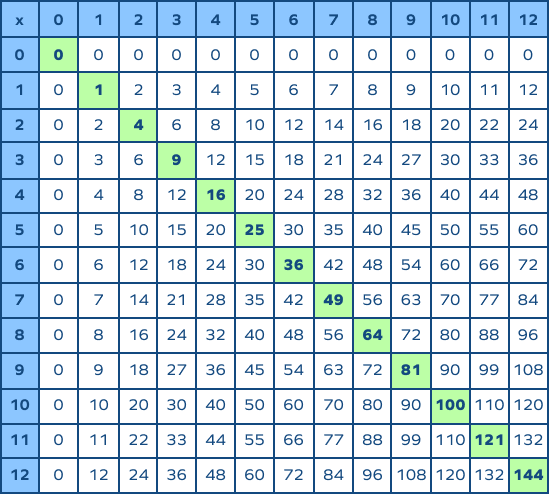What Is a Square Number in Math?
A square number is a number obtained when an integer is multiplied by itself. It is also referred to as “a perfect square.”
We know that the product of a positive integer with a positive integer is always positive. Also, the product of a negative integer and a negative integer is always positive.
$(+) \times (+) = (+)$
$(-) \times (-) = (+)$
Thus, the square numbers obtained by multiplying an integer with itself are always positive.
Examples of square numbers:
- $5 \times 5 = 25$
- $(-8) \times (-8) = 64$
Recommended Games
Square Number: Definition
A square number can be defined as the positive integer obtained by multiplying an integer with itself.
Recommended Worksheets
Properties of Square Numbers
- Square numbers always have the digits 0, 1, 4, 5, 6, or 9 as their last digits.
- A number ending with 2, 3, 7, or 8 cannot be a square number.
- A square number always has an even number of zeros at the end. Therefore, a number is not a square if it has an odd number of zeros as the last digits. For example, the numbers 900 and 4900 are square numbers while 20, 360, and 480 are not squares.
- The square of a number ends with 1 when the last digit of an integer is either 1 or 9.
- The square number of an integer ends with 6 if its last digit is either 4 or 6.
- The square number of an even integer is always an even integer, while the square of an odd number is always an odd number.
- Square numbers are always positive.
- If a number’s square root is a fraction or a decimal number, it is not a perfect square number. For instance, $\sqrt{0.25} = 0.5$, hence 0.25 is not a square number.
List of Square Numbers (1 to 100)
Here is a list of all of the square numbers from 1 to 100.
| Number | Square | Number | Square | Number | Square | Number | Square |
|---|---|---|---|---|---|---|---|
| 1 | 1 | 26 | 676 | 51 | 2601 | 76 | 5776 |
| 2 | 4 | 27 | 729 | 52 | 2704 | 77 | 5929 |
| 3 | 9 | 28 | 784 | 53 | 2809 | 78 | 6084 |
| 4 | 16 | 29 | 841 | 54 | 2916 | 79 | 6241 |
| 5 | 25 | 30 | 300 | 55 | 3025 | 80 | 6400 |
| 6 | 36 | 31 | 961 | 56 | 3136 | 81 | 6561 |
| 7 | 49 | 32 | 1024 | 57 | 3249 | 82 | 6724 |
| 8 | 64 | 33 | 1089 | 58 | 3364 | 83 | 6889 |
| 9 | 81 | 34 | 1156 | 59 | 3481 | 84 | 7056 |
| 10 | 100 | 35 | 1225 | 60 | 3600 | 85 | 7225 |
| 11 | 121 | 36 | 1296 | 61 | 3721 | 86 | 7396 |
| 12 | 144 | 37 | 1369 | 62 | 3844 | 87 | 7569 |
| 13 | 169 | 38 | 1444 | 63 | 3969 | 88 | 7744 |
| 14 | 196 | 39 | 1521 | 64 | 4096 | 89 | 7921 |
| 15 | 225 | 40 | 1600 | 65 | 4225 | 90 | 8100 |
| 16 | 256 | 41 | 1681 | 66 | 4356 | 91 | 8281 |
| 17 | 289 | 42 | 1764 | 67 | 4489 | 92 | 8464 |
| 18 | 324 | 43 | 1849 | 68 | 4624 | 93 | 8649 |
| 19 | 361 | 44 | 1936 | 69 | 4761 | 94 | 8836 |
| 20 | 400 | 45 | 2025 | 70 | 4900 | 95 | 9025 |
| 21 | 441 | 46 | 2116 | 71 | 5041 | 96 | 9216 |
| 22 | 484 | 47 | 2209 | 72 | 5184 | 97 | 9409 |
| 23 | 529 | 48 | 2304 | 73 | 5329 | 98 | 9604 |
| 24 | 576 | 49 | 2401 | 74 | 5476 | 99 | 9801 |
| 25 | 625 | 50 | 2500 | 75 | 5625 | 100 | 10000 |
Two-digit Square Numbers
There are only six “two-digit square numbers.”
$4 \times 4 = 16$
$5 \times 5 = 25$
$6 \times 6 = 36$
$7 \times 7 = 49$
$8 \times 8 = 64$
$9 \times 9 = 81$
Three-digit Square Numbers
There are only 22 three-digit square numbers.
100, 121, 144, 169, 196, 225, 256, 289, 324, 361, 400,
441, 484, 529, 576, 625, 676, 729, 784, 841, 900, 961.
Odd and Even Square Numbers
The meaning of a square number is simple; when we multiply a number by itself we get a square number. These square numbers can be divided into two types:
- Even square numbers: The square of any even number is always an even square number. For example, $2^{2} = 4,\; 6^{2} = 36$
- Odd square numbers: The square of any odd number is always an odd square number. For example, $3^{2} = 9,\; 7^{2} = 49$
Square Numbers and Multiplication Arrays
The name “square” comes from the fact that all square numbers can be represented using a square-shaped array. They fill a square.
The following figure has the number of balls arranged in a square. We can see that the number of balls that fill a square is a square number.
If we take 4 balls, we can see that they can be arranged in an array to form a square shape. Same goes for the square numbers 9, 36, etc.

Square Numbers on Multiplication Chart
Notice that the square numbers appear diagonally in a multiplication chart.

Facts about Square Numbers
- The square of any number “n” is equivalent to the sum of the first “n” odd natural numbers. For example, $4^{2} = 16 = 1 + 3 + 5 + 7$
- If an integer ends with 5, there’s a trick you can use to find its square. If the given integer is of the form $\left[n\right]5$, then the square will be $\left[n \times(n + 1)\right]\left[25\right]$.
- Difference of squares formula $= a^{2} \;-\; b^{2} = (a + b)(a \;-\; b)$
Example: $45 = \left[4 \times 5\right]\left[25\right] = 2025$ - The sum of squares of the first $n$ natural numbers $\left(1,\; 2,\; 3,…, n\right)$ is given by
$\sum_{i = 1}^{n}i = \frac{n (n + 1) (2n + 1)}{6}$
Conclusion
In this article, we learned about square numbers, their properties along with the list of squares from 1 to 100. Let’s solve a few examples and practice problems.
Solved Examples on Square Numbers
1. Find the square of 89.
Solution:
To find the square of the number 89, we need to multiply 89 by 89.
$89^{2} = 89 \times 89$
$89 \times 89 = 7921$

2. Find the square of -25.
Solution:
The square of $-\;25$ would be the product of $-\;25$.
$(\;-\;25)^{2} = (\;-\;25) \times (\;-\;25)$
$(\;-\;25)^{2} = 625$
3. Is 113 a square number?
Solution:
All square numbers end with 0, 1, 4, 5, 6, or 9.
If a number ends with 2, 3, 7, or 8, then it is not a square number.
Practice Problems on Square Numbers
Square Numbers: Definition, List, Examples
Which of the following is a square number?
3600 is the square of the number 60.
What is the square of -24?
The square of any negative number is always positive.
$(\;-\;24)^{2} = 576$
$(65)^{2} =$
$65^{2} = 4225$
If $m^{2} = n$, then $(\;-\;m)^{2} =$
If $m^{2} = n$, then $(\;-\;m)^{2} = n$
Frequently Asked Questions on Square Numbers
What are the first five square numbers?
The first five square numbers are 1, 4, 9, 16, and 25.
What is a principal square root?
Every number except 0 has two square roots, positive and negative. The positive square root is called the principal square root.
What is the square of 0?
The square of 0 is 0.




































